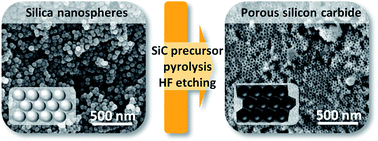Polymer-derived nanoporous silicon carbide with monodisperse spherical pores†
Abstract
The synthesis of

* Corresponding authors
a
Department of Inorganic Chemistry, Dresden University of Technology, Bergstrasse 66, D-01069 Dresden, Germany
E-mail:
Stefan.kaskel@chemie.tu-dresden.de
Fax: +49-3510463-37287
Tel: +49-351463-34885
b Chair of Polymer Chemistry, Chemnitz University of Technology, Strasse der Nationen 62, D-09111 Chemnitz, Germany
c Institute for Complex Materials, Leibniz Institute for Solid State and Materials Research (IFW) Dresden, Helmholtzstraße 20, D-01069 Dresden, Germany
d Institute of Materials Science, Dresden University of Technology, Helmholtzstraße 7, D-01069 Dresden, Germany
The synthesis of

 Please wait while we load your content...
Something went wrong. Try again?
Please wait while we load your content...
Something went wrong. Try again?
C. Hoffmann, T. Biemelt, A. Seifert, K. Pinkert, T. Gemming, S. Spange and S. Kaskel, J. Mater. Chem., 2012, 22, 24841 DOI: 10.1039/C2JM34799G
To request permission to reproduce material from this article, please go to the Copyright Clearance Center request page.
If you are an author contributing to an RSC publication, you do not need to request permission provided correct acknowledgement is given.
If you are the author of this article, you do not need to request permission to reproduce figures and diagrams provided correct acknowledgement is given. If you want to reproduce the whole article in a third-party publication (excluding your thesis/dissertation for which permission is not required) please go to the Copyright Clearance Center request page.
Read more about how to correctly acknowledge RSC content.
 Fetching data from CrossRef.
Fetching data from CrossRef.
This may take some time to load.
Loading related content
